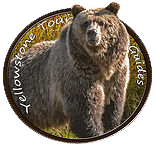Is Yellowstone the Largest National Park?
At 2.2 million acres, Yellowstone National Park would seem to be a good candidate for “largest national park.” However, Yellowstone does not currently hold this title. Read on to discover which park tops the size scale and learn other fun facts about Yellowstone National Park and its sister parks.
Largest national park
The largest park in the National Park System is Wrangell-St. Elias National Park and Reserve in Alaska. In fact, more than half of the national parks in Alaska are larger than Yellowstone National Park. In the contiguous United States, Yellowstone did hold the title for largest national park until 1994. At that time, Death Valley National Monument became a national park. It was also expanded to its current 3 million-plus acres, which beats Yellowstone in size.
Most visited national park
Yellowstone National Park ranks among the top five national parks for the number of visitors it welcomes every year. Great Smoky Mountains National Park typically takes the title.
Highest peak in the park
The highest peak in Yellowstone National Park reaches 11,358 feet. Named Eagle Peak, this crest can be found in the southeastern region of the park.
Features of the park
Yellowstone National Park is home to Yellowstone volcano. The underlying body of magma from this volcano creates a unique hydrothermal system that features five types of hydrothermal landscapes. In total, the park boasts more than 10,000 hydrothermal features:
- Hot springs: These are pools of water that are heated by the volcanic activity.
- Geysers: When hot springs experience tightening in their plumbing, they occasionally erupt to release the built-up pressure, which creates a geyser.
- Mudpots: This type of hot spring is one that is highly acidic and dissolves the rock surrounding it.
- Travertine terraces: These terraces are created when hot springs rise through the limestone, dissolve calcium carbonite and deposit the calcite.
- Fumaroles: Also referred to as steam vents, these openings release hot steam instead of water.
Animals of the park
Yellowstone National Park is famous for its bison population. This is the only location in the U.S. where these animals have lived continuously for thousands of years. It is the home of the largest bison population in the country on public land.
The park is also home to 66 other mammals. These include grizzly bears, black bears, gray wolves, elk, white-tailed deer and bighorn sheep. In the waters of Yellowstone National Park, you’ll find 11 native species of fish, including trout, whitefish, suckers and graylings. Throughout the park, you can encounter 300 species of birds, including the common loon, golden eagle and trumpeter swan.
Discover more
Learn even more about the park by exploring it in person! Contact Yellowstone Tour Guides for tours, sightseeing and hikes throughout Yellowstone National Park. Since 2001, our experienced guides have been dedicated to showing visitors the beauty of Yellowstone. We look forward to exploring the park with you and helping you discover all its incredible wonders that can’t be found anywhere else on the planet. Reach Yellowstone Tour Guides today at 406-995-2399.
